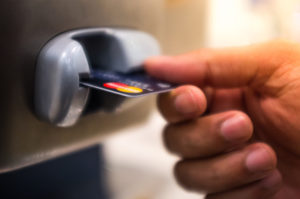Caption: iStock/GCShutter
Skimming fraud has been around for more than a decade, and continues to evolve. Today’s skimmers – illegal card-reading devices placed on ATMs, gas pumps and other public-area machines that process debit cards – are stealthier and more sophisticated than ever.
These devices “skim” information from the card’s magnetic strip as a nearby hidden camera, also placed by skimming scammers, records the PIN that you enter. Although you get your cash or can make a purchase – none the wiser of a skim scam flim-flam – the crooks can get more: Using information from the skimmer and camera, they make duplicate cards to drain cash from your accounts, or sell your card number and PIN for others to fleece you.
The good news: In most cases, stolen funds are usually reimbursed provided you report the fraud to the card-issuing bank within 60 days (another reason to keep close and timely tabs on accounts).
The better news: With a few simple steps before you use your card, you may be able to detect skimmers and tampered machines to avoid potential trouble. Here’s how:
- Pull on the slot. The latest generation of card-reading devices, used with increasing frequency by skimming scammers, are thin “insert skimmers” that fit inside the card slot at an ATM or gas pump. “New evidence suggests that at least some of these insert skimmers – which record card data and store it on a tiny embedded flash drive – are equipped with technology allowing them to transmit stolen card data wirelessly via infrared, the same communications technology that powers a TV remote control,” reports noted cybersecurity blogger Brian Krebs (who provides photos of insert skimmers). So before using the machine, squeeze, wiggle and tug the insert slot to remove insert skimmers, along with some old-school models placed over the card slot that protrude outward. In general, card slots should be flush against the machine; be suspicious of those where the entire or half of the slot sticks out.
- Check for spy cameras. Although skimmers record data from a credit or debit card’s magnetic stripe, fraudsters also need your PIN in order to withdrawal cash or sell cloned cards. To glean PINs, they place pinhole “spy” cameras that collect numbers as they’re being typed on the keypad. Look for small holes just above the display screen, on an attached brochure or other type of box, or even on protruding covers placed over the cash dispenser. Even if you can’t detect evidence of a camera, cover your hand when entering your PIN.
- Avoid “void” stickers. To help spot skimmer tampering at gas pumps, many stations now place security seals over the cabinet panel as part of a voluntary program, notes the Federal Trade Commission. If the pump panel has been opened – an indication of possible skimmer placement – the label will read “void” and take that clue to fill your car elsewhere. Still, whenever you use a debit card at the pump, you’re safest by pressing the “credit” button instead of “debit.” This way, you can still use your debit card without having to enter a PIN, and the purchase amount is processed through a credit card network that provides greater protection if fraud occurs.
- Inspect the keypad. False keypad overlays that look exactly like, and fit directly over, the real McCoy are another way fraudsters can collect PINs as accompanying skimmers get card data. So before entering your card, check the keypad – and think twice before using if it feels loose, spongy, or the keypad panel appears raised or thicker compared to the rest of the machine. Also before using, give several buttons a test run and be suspicious if they feel sticky. Crooks have been known to place glue on and around certain buttons – particularly “enter,” “cancel” and “clear” – to prevent customers from completing a transaction after inserting a cash card and keying in a PIN. (When customers go inside a bank to report the problem, the waiting thief “unsticks” the buttons with a knife to complete the withdrawal.)
- Check the audio jack. Most ATMs have an audio jack that goes unnoticed to the average customer – and that works to their advantage. If not perfectly centered inside the plastic overlay cover, it suggests the machine has been tampered with. Another tampering tipoff: Look for cracks or cuts on the plastic covering the receipt slot, cash dispenser or other portions of the machine; these coverings should be completely smooth.
For information about other scams, sign up for the Fraud Watch Network. You’ll receive free email alerts with tips and resources to help you spot and avoid identity theft and fraud, and keep tabs of scams and law enforcement alerts in your area at our Scam-Tracking Map.















